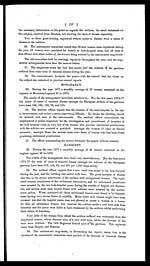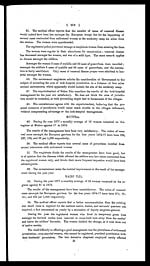Medicine - Institutions > Lock hospitals > Annual report on the working of the lock hospitals in the North-Western Provinces and Oudh > Fourth annual report on the working of the lock-hospitals in the North-Western Provinces and Oudh for the year 1877
(126) Page 118
Download files
Individual page:
Thumbnail gallery: Grid view | List view

( 118 )
during the year was due to the fact that many of the wives of the camp-followers of
the 22nd Regiment had intercourse with the soldiers. These women were found to be
diseased and were removed from cantonments.
ROORKEE.
35 During the year 1877 a monthly average of 20 women remained on the
register against 21 in 1876.
The results of the management have been most satisfactory.
For the four years 1874-77 the ratios of cases of venereal disease amongst the Euro-
pean soldiers of the garrison have been 198, 146, 124, and 66 per 1,000 respectively.
36 The medical officer reports that of the 30 cases of disease which occurred
amongst the soldiers 6 were contracted at Delhi, and of the cases which commenced
at Roorkee were probably not often derived from registered women; for whilst amongst
the women the prevailing disease was syphilis, amongst the men the prevailing disease
was gonorrhœa.
The registered women were always submissive, quiet, and orderly. Disease amongst
the garrison was confined to the soldiers of the British infantry.
37 The cantonment magistrate notes the fact that the slight amount of disease
which prevailed was confined to the infantry regiment. The Royal Engineers or
college students enjoyed perfect immunity. This peculiarity may be due to the pre-
ference the infantry soldier of small means shows for cheap unregistered coolie
women and milk-sellers.
38 The magistrate forwards the papers without remark.
39 The commissioner notes the satisfactory working of the institution, and
points out that here, as in most cases, disease, as regards the regular prostitutes, has
been fairly grappled with, but disease arising from connection with women who occa-
sionally prostitute themselves has not been prevented.
SHÁHJAHÁNPUR.
40 During the year 1877 a monthly average of 35 women remained on the
register against 37 in 1876.
The results of the management have been very unsatisfactory.
For the three years 1875-77 the ratios of cases of venereal disease amongst the
European garrison have been 263, 224, and 305 per 1,000 respectively.
41 The medical officer reports that of the total of 129 cases of disease which
occurred amongst the soldiers 33 were eases of secondary syphilis. Deducting these
the ratio falls to 227. Of the remaining 96 cases 40 were cases of syphilis and 56
cases of gonorrhœa. Of 179 cases of disease amongst the women 26 were cases of
syphilis, 30 cases of gonorrhœa, and 123 cases of minor disease, probably not venereal.
42 The magistrate thinks the results of the working of the year were really
satisfactory, as although the total number of cases of disease amongst the soldiers was
greater than in 1876, the number of cases of primary syphilis was less.
43 The commissioner notes a progressive increase of disease amongst the
soldiers at Sháhjahánpur for the past three years, but thinks that as the increase in 1877
was due to cases of secondary syphilis and gonorrhœa only, improvement is noticeable
for that year.
CHAKRÁTA.
44. During the year 1877 a monthly average of 24 women remained on the
register at Chakráta against 23 in 1876.
The results of the management have been very satisfactory. The ratio of venereal
cases amongst the European garrison for the four years 1874-77 have been 59, 58, 112,
and 98 per 1,000 respectively.
Set display mode to: Large image | Zoom image | Transcription
Images and transcriptions on this page, including medium image downloads, may be used under the Creative Commons Attribution 4.0 International Licence unless otherwise stated. ![]()
| Permanent URL | https://digital.nls.uk/75111210 |
|---|




